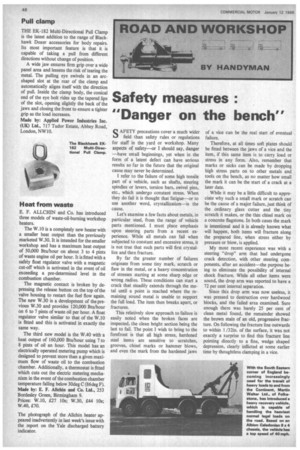Safety measures : "Danger on the bench"
Page 48

If you've noticed an error in this article please click here to report it so we can fix it.
SAFETY precautions cover a much wider field than safety rules or regulations for staff in the yard or workshop. Many aspects of safety—or I should say, danger —have small beginnings, yet when in the form of a latent defect can have serious results so far in the future that the original cause may never be determined.
I refer to the failure of some high tensile part of a vehicle, such as shafts, steering spindles or levers, torsion bars, swivel pins, etc., which undergo constant stress. When they do fail it is thought that fatigue—or to use another word, crystallization—is the cause.
Let's examine a few facts about metals, in particular steel, from the range of vehicle parts mentioned. I must place emphasis upon steering parts from a recent experience. While all metals can fail when subjected to constant and excessive stress, it is not true that such parts will first crystallize and then fracture.
By far the greater number of failures originate from some tiny mark, scratch or flaw in the metal, or a heavy concentration of stresses starting at some sharp edge or wrong radius. These conditions can start a crack that steadily extends through the metal until a point is reached where the remaining sound metal is unable to support the full load. The item then breaks apart, or fractures.
This relatively slow approach to failure is easily noted when the broken faces are inspected, the clean bright section being the last to fail. The point I wish to bring to the forefront is that all high stress, hardened steel items are sensitive to scratches, grooves, chisel marks or hammer blows, and even the mark from the hardened jaws of a vice can be the real start of eventual failure.
Therefore, at all times soft plates should be fitted between the jaws of a vice and the item, if this same item is to carry load or stress in any form. Also, remember that marks or nicks can be made by dropping high stress parts on to other metals and tools on the bench, as no matter how small the mark it can be the start of a crack at a later date.
While it may be a little difficult to appreciate why such a small mark or scratch can be the cause of a major failure, just think of the ordinary glass cutter and the tiny scratch it makes, or the thin chisel mark on a concrete flagstone. In both cases the mark is intentional and it is already known what will happen, both items will fracture along the prepared line, when stress either by pressure or blow, is applied.
My most recent experience was with a steering "drop" arm that had undergone crack detection, with other steering components, after an accident—the purpose being to eliminate the possibility of internal shock fracture. While all other items were sound, the drop arm was reported to have a 72 per cent internal separation.
Since this drop arm was now useless, it was pressed to destruction over hardwood blocks, and the failed area examined. Sure enough there was barely 25 per cent of clean metal found, the remainder showed the brown stain of an old, progressive fracture. On following the fracture line outwards to within 1 /32in. of the surface, it was not exactly a surprise to find this fracture line pointing directly to a fine, wedge shaped depression, clearly inflicted at some earlier time by thoughtless clamping in a vice.
















































































































